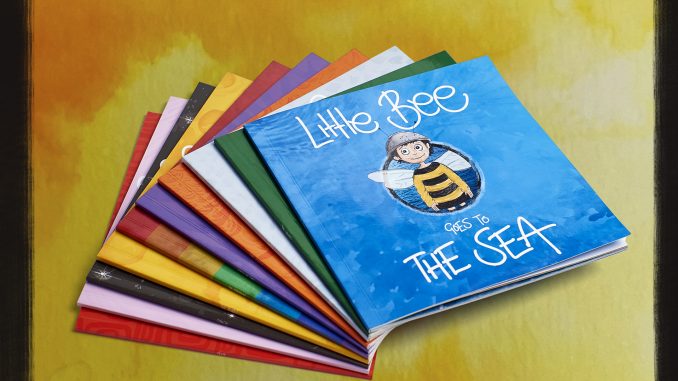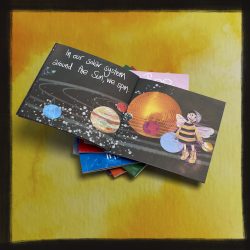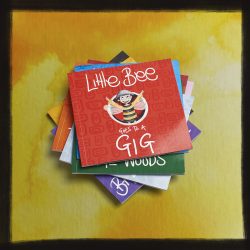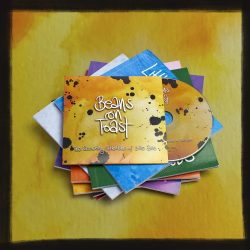
 I suspect I am not alone in feeling that good children’s books have an air of excitement, beauty, and comfort. I believe pre and primary-school children’s books should make the reader and the listener feel fuzzy, warm, excited, curious, loved and hugged. The books should be attractive, comforting to hold and with engaging illustrations that delight, help tell the story and instigate conversation. The stories need to be relevant and age-appropriate and take every opportunity to impart knowledge and reason in a fun way. That is a big ask for any author, but it is the least our children deserve as they learn to navigate each new day and experience in life.
I suspect I am not alone in feeling that good children’s books have an air of excitement, beauty, and comfort. I believe pre and primary-school children’s books should make the reader and the listener feel fuzzy, warm, excited, curious, loved and hugged. The books should be attractive, comforting to hold and with engaging illustrations that delight, help tell the story and instigate conversation. The stories need to be relevant and age-appropriate and take every opportunity to impart knowledge and reason in a fun way. That is a big ask for any author, but it is the least our children deserve as they learn to navigate each new day and experience in life.
‘The Fascinating Adventures of Little Bee‘ series of ten books take an inquisitive, gender-neutral child dressed as a bee on a series of intriguing adventures that give glimpses into various situations and experiences. Young children love and learn from repetition and rhyme, which this series is robust on. Each of the Little Bee stories is told similarly. Each story is accompanied by its own song, individually styled across various genres, including folk, RnB, disco, rock n roll, rockabilly, and synth-pop. All on one separate CD which comes with the book set. The chorus to each song is the same, which is an excellent feature as such easy familiarity is always a winner, with old and young alike.
The subjects, experiences, and lessons learnt by Little Bee and the readers are wide and varied, although not always reflecting real-life possibilities. On occasion they stray from the topic, making the title somewhat irrelevant. That said, make-believe has always relied greatly on poetic licence.
‘Little Bee Goes to The Sea‘: ‘an all-important lesson about curiosity’.
Little Bee swims beneath the waves meeting all kinds of sea creatures and finding long-lost treasures.
‘Little Bee Goes to The Woods‘: ‘the wisdom of patience’.
Little Bee patiently listens to the trees as their sounds change through the seasons. There are images of lots of woodland animals seen sleeping underground to generate much curiosity and conversation.
‘Little Bee Goes to Town‘: ‘society and the power of community.’
Little Bee discovers much of what goes on in a town and how it takes a lot of different people and jobs to create a sense of community.
‘Little Bee Goes to The City‘: ‘unforgettable lessons about arts, culture, and diversity.’
The city depicted, although it isn’t actually named, is London. Little Bee sees the wide range of experiences and nationalities that make up a diverse society.
‘Little Bee Goes Back in Time‘: ‘history, dinosaurs and where we fit in.’
In this instance, Little Bee returns to the dinosaur age.

‘Little Bee Goes to The Rainbow‘: ‘colour and how it shapes the world in which we live.’
This story is all about colours rather than an actual rainbow.
‘Little Bee Goes to The Moon‘: ‘poetry, rhythm, rhyme, and reason.’
This story describes the beauty of poetry. Older generations may realise it is drawing on the moon’s tidal effect, but this is not reflected in the story.
‘Little Bee Goes to Space‘: ‘the universe, galaxies, solar systems, planets and the infinite.’
A good look at what is out there in space creates as many questions as it gives answers.
‘Little Bee Goes to an Imaginary world‘: ‘the importance of stories and storytelling.’ Creative licence used at its best.

‘Little Bee Goes to a gig‘: ‘where the band play loud and the crowd cheer louder.’
Little Bee’s adventures are summed up in this last story whilst depicting the thrill of live music.
The Little Bee series was created and written by folk singer Beans on Toast with friends Jaime and Lily Adamsfield, a nurse and a teacher, respectively, and aimed at 2–10-year-olds. The three creators decided on the adventures, Beans on Toast wrote the stories, and Lily did the illustrations. The songs are all written and performed by Mr. Toast. Little has been overlooked with this series. The images are clear, bright and attractive. The small amount of text on each page leaves lots of room for discovery in the illustrations. However, the actual font of the text may not be appropriate for the age group, as it isn’t in the style that children learn to form letters, which may stall some young readers. Also, not dotting the letter ‘i’ is a missed opportunity to impress on the need for correct spelling and punctuation. As we all know, children are capable of incredible subliminal attention to detail.

Each of the books has a page of interesting facts about the subject, giving the older children in the age range plenty to think about and talk about. There is also a ‘find Little Bee’ page, which draws on a familiar theme from other book series and is excellent fun for young and old alike. What further adds to the appeal of this set of books is the ‘now play along’ page each one has at the end. For young budding musicians; fundamental guitar, ukulele, or piano chords are shown in both finger positioning and note form. Each story is also rewritten as lyrics, with relevant musical notation. Where this has not been possible, there are lively ideas for making drums and shakers to play along with the music or creating a chant.
In addition, the set will also offer access to a digital treasure trove of additional online entertainment, including dance videos, guitar lessons, craft workshops, and audio narrations of each book by its creators.
Overall, a technicolour, fun-packed, interesting, educational, and musical extravaganza.


